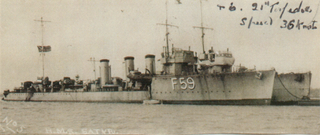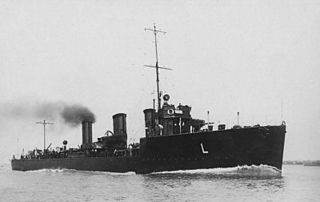
HMS Erebus was a First World War monitor launched on 19 June 1916 and which served in both world wars. She and her sister ship Terror are known as the Erebus class. They were named after the two bomb vessels sent to investigate the Northwest Passage as part of Franklin's lost expedition (1845–1848), in which all 129 members eventually perished.

The M29 class comprised five monitors of the Royal Navy, all built and launched during 1915.

HMS Terror was an Erebus-class monitor built for the Royal Navy during the First World War in Belfast. Completed in 1916, she was assigned to the Dover Patrol where her primary duties involved bombarding German targets on the coast of occupied Belgium, particularly at the ports of Zeebrugge and Ostend. In October 1917 Terror was hit by three torpedoes, taking severe damage to the bow and had to be towed into Portsmouth for repair. In April 1918 she participated in the Zeebrugge raid and provided gunnery support for the Fifth Battle of Ypres in September of the same year.

The Marshal Ney class was a class of monitor built for the Royal Navy during the First World War.

HMS Marshal Ney was the lead ship of her class of two monitors built for the Royal Navy during the First World War. Laid down as M13, she was renamed after the French field marshal of the Napoleonic Wars Michel Ney. After service in the First World War, she became a depot ship and then an accommodation ship. Between 1922 and 1947, she was renamed three times, becoming successively Vivid, Drake and Alaunia II. She was scrapped in 1957.
HMS Faulknor was a British destroyer of the First World War. She was purchased by the Royal Navy whilst still under construction in Britain for the Chilean Navy who had ordered her in 1912 as part of the Almirante Lynch class. She was renamed after the Faulknor family of British nineteenth century naval officers.

The Humber-class monitors were three large gunboats under construction for the Brazilian Navy in Britain in 1913. Designed for service on the Amazon River, the ships were of shallow draft and heavy armament and were ideally suited to inshore, riverine and coastal work but unsuitable for service at sea, where their weight and light draft reduced their speed from a projected twelve knots to under four. The class comprised Humber, Mersey and Severn. All three were taken over by the Royal Navy shortly before the outbreak of the First World War and were commissioned as small monitors. All three saw extensive service during the war and were sold in 1919.
HMS Starfish was an R-class destroyer which served with the Royal Navy. She was launched on 27 September 1916 and sold to be broken up on 21 April 1928. She was built by Hawthorn Leslie of Hebburn Tyne.

HMS Torrent was a Royal Navy R-class destroyer constructed and then operational in the First World War. She was sunk, with most of her crew in 1917. On 23 December 1917 Surprise, HMS Torrent, and Tornado sank after entering an Imperial German minefield.

HMS Surprise was a Royal Navy R-class destroyer constructed and then operational in the First World War. She was sunk, with most of her crew in 1917. On 23 December 1917 HMS Surprise, Torrent, and Tornado sank after entering an Imperial German minefield.

HMS Teazer was an R-class destroyer which served with the Royal Navy during World War I. The destroyer was launched in April 1917 and, on trial, proved to be one of the fastest afloat, exceeding 40 knots. Attached to the Harwich Force, the ship supported the monitors Erebus, Terror and Marshal Soult in the bombardment of Zeebrugge in May 1918 and one of the final sorties of the war in the October following. The destroyer also took part in operations off the coast of Heligoland with a flying boat on a lighter, although the aircraft failed to take off. After the war, Teazer was kept in reserve until being sold to be broken up in 1931 following the signing of the London Naval Treaty that limited total destroyer tonnage.

HMS Satyr was an R-class destroyer which served with the Royal Navy during the First World War. Launched on 27 December 1916, Satyr joined the Harwich Force under the command of Commander Hubert de Burgh. In 1917, the destroyer formed part of a force protecting the monitors Erebus and Terror in their bombardment of Ostend. As part of this action, Satyr, along with sister ships Taurus, Sharpshooter and Torrent, sank the German destroyer S20. After the war, the ship served with the Torpedo School at the Devonport. In 1923, the Navy decided to retire many of the older destroyers in preparation for the introduction of newer and larger vessels and Satyr was sold to be broken up on 16 December 1926.

HMS Manly was a Yarrow M-class destroyer of the British Royal Navy. Built by the Scottish shipbuilder Yarrow between 1913 and 1914, Manly served during the First World War. She formed part of the Harwich Force in the early years of the war, and then later in the English Channel as part of the Dover Patrol taking part in the Zeebrugge Raid in 1918. She survived the war, and was sold for scrap in 1920.

HMS Springbok was an R-class destroyer which served with the Royal Navy during World War I. The R class were an improvement on the preceding M-class, including using geared steam turbines. Launched on 9 March 1917, the vessel operated as part of the Harwich Force on escort duties. In 1917, the destroyer, along with sister ship Thruster, captured the German merchant ships Brietzig and Pellworm. After the conflict, the destroyer initially was posted to the navy's torpedo school but was soon afterwards reduced to reserve. After less than ten years in service, Springbok was sold on 16 December 1926 and broken up.

HMS Redgauntlet was an R-class destroyer which served with the Royal Navy. Launched on 2 July 1916, the ship operated as part of the Harwich Force during World War I and then, after the War, with the Home Fleet. While taking part in an anti-submarine patrol on 21 May 1917, the ship struck a mine but, although severely damaged, was able to return to England for repairs. Subsequently, the destroyer joined the anti-submarine school at Portsmouth before being sold to be broken up on 16 December 1926 after less than ten years service.

HMS Lochinvar was a repeat Laforey-class destroyer which served with the Royal Navy during the First World War. Named after the character in the poem Marmion, the ship was originally to be called HMS Malice but was renamed prior to being launched on 9 October 1915. The destroyer joined the Harwich Force and took part in anti-submarine patrols, as well as escorting the monitors Erebus and Terror for their attacks on the canal gates at Zeebrugge and the port of Ostend in 1917. After the Armistice, the vessel was placed in reserve and sold to be broken up on 25 November 1921.

HMS Moorsom was an Admiralty M-class destroyer which served in the Royal Navy during the First World War. The M class were an improvement on the preceding L class, capable of higher speed. Moorsom, the first ship to enter navy service to be named after Admiral Sir Robert Moorsom, was launched in December 1914, initially serving as part of the Grand Fleet before being transferred to the Harwich Force the following year. Briefly rejoining the Grand Fleet, the destroyer saw service in the Battle of Jutland in 1916 supporting the British battlecruisers and received hits from a battleship of the German High Seas Fleet. Moorsom also undertook other duties, including escorting the troop ship Mauretania in June 1915 and the minelayer Princess Margaret in August 1915 and November 1916. Placed within the Dover Patrol, the destroyer formed part of the cover for monitors including Erebus and Terror on attacks on Ostend and Zeebrugge in May and June 1917, and April and May 1918. After the Armistice, the destroyer was placed in reserve and subsequently sold to be broken up in November 1921.

HMS Morris was an Admiralty M-class destroyer which served with the Royal Navy during the First World War. The M class were an improvement on the preceding L class, capable of higher speed. The ship, the only vessel to be named Morris to serve with the Royal Navy, was launched on 19 November 1914. Joining the Grand Fleet as part of a new flotilla, the destroyer was soon in action, serving as part of a destroyer screen during the Battle of Dogger Bank in January 1915 and an escort to the minelayer Princess Margaret during a skirmish with German torpedo boats eight months later. At the Battle of Jutland in 1916, the destroyer was a crucial part of the flotilla that drove the German torpedo boats away from the British battlecruisers. Morris received no hits during these confrontations. The destroyer assisted in the rescue of survivors from the R-class destroyer Simoom and the recovery of the damaged flotilla leader Botha in 1917. The ship also undertook general duties including escorting merchant ships, minelayers, monitors, and the seaplane carrier Vindex. After the armistice that ended the war, the destroyer was considered superfluous to requirements, Initially placed in reserve, Morris was decommissioned and, on 8 November 1921, sold to be broken up.

HMS Sylph was an R-class destroyer that served in the Royal Navy during the First World War. The R class were an improvement on the previous M class with geared steam turbines to improve efficiency. Launched by Harland & Wolff at Govan on 10 February 1917, Sylph joined the Harwich Force and escorted merchant ships and convoys in the North Sea. The ship encountered both German submarines and torpedo boats but did not record any hits on the enemy. However, during one action in foggy weather, the destroyer struck and sank sister ship Setter. After the Armistice that ended the war, the destroyer was initially placed in the reserve before being transferred to the Torpedo School in 1919. On 16 December 1926, Sylph was sold to be broken up.

HMS Stork was an R-class destroyer that served in the Royal Navy during the First World War. The R-class were an improvement on the previous M-class with geared steam turbines to improve efficiency. Launched by Hawthorn Leslie at Hebburn in 1917, Stork joined the Harwich Force. The destroyer saw service escorting convoys in the English Channel and encountered both German submarines and torpedo boats, but did not record any hits on the enemy. The vessel also supported attacks on German forces on the coast of Western Europe by Coastal Motor Boats, flying boats and monitors, including the Zeebrugge Raid of 1918.














